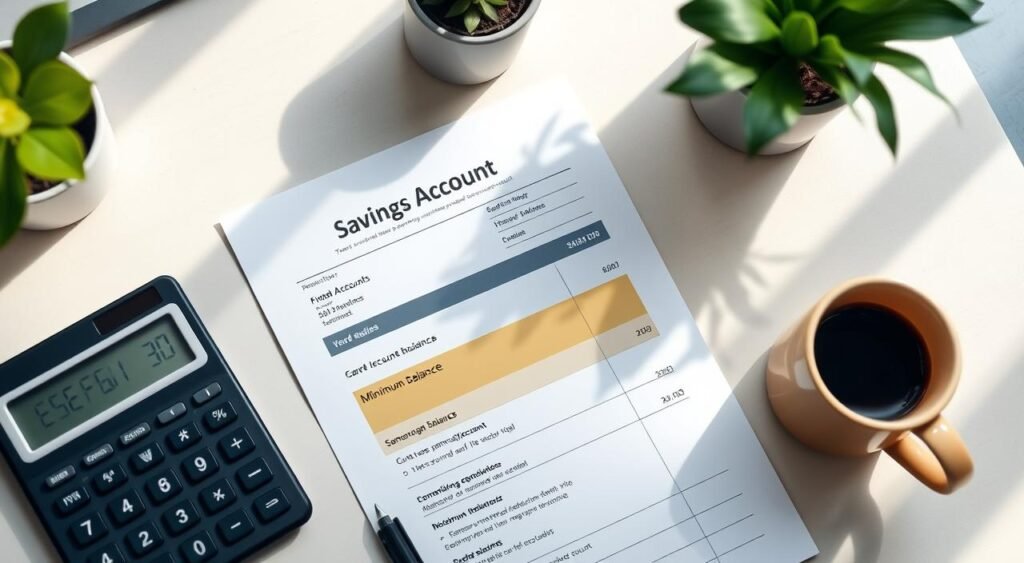Imagine you’ve worked hard and saved a lot. Now, you want your money to grow. But with so many savings options, picking the right one can be tough. Finding high-interest rates doesn’t have to be complicated.
In today’s world, high-yield savings accounts are changing the game. They offer rates much higher than the national average. Some accounts have APYs around 5%, which means big growth potential. But it’s not just about the numbers. It’s about finding an account that fits your financial journey.
We’ll look at how these accounts can help you reach your financial goals. We’ll cover APYs and the pros and cons of different banks. This guide will help you make a smart choice. Let’s start this journey to grow your savings and secure your future.
Key Takeaways
- High-yield savings accounts offer APYs around 5%, significantly higher than the national average of 0.46%.
- Top-performing accounts include Poppy Bank and Pibank, both offering 5.50% APY.
- Minimum deposit requirements vary, with some accounts requiring no minimum balance.
- Recent Federal Reserve rate cuts may impact future yields, making comparison shopping crucial.
- FDIC insurance provides security for deposits up to $250,000 per bank, per depositor.
Understanding High-Yield Savings Accounts

High-yield savings accounts are a smart way to grow your money. They offer higher interest rates than regular savings. This makes them great for building an emergency fund or saving for short-term goals.
What is a high-yield savings account?
A high-yield savings account gives you interest rates way above the national average. While regular savings accounts might give you 0.39% APY, high-yield accounts can go up to 5% APY. This big difference can really help your savings grow over time.
How do they differ from traditional savings accounts?
The main difference is in the interest rates. For example, a $10,000 deposit in a regular savings account might earn you $33 in a year. But, the same amount in a high-yield savings account with a 4.88% APY could earn $488. That’s over 14 times more! Many online banks offer these accounts, giving you better rates because they have lower costs.
The benefits of high-yield savings
High-yield savings accounts have many benefits:
- Higher interest rates for faster growth
- Compound interest to boost earnings
- FDIC insurance up to $250,000
- Often lower fees than traditional banks
- Easy access to funds for emergencies
When picking a high-yield account, think about interest rates, how easy it is to get your money, how often interest compounds, and any minimum deposit needs. With the right account, your savings can work harder for you. This is true whether you’re saving for an emergency or a specific goal.
Current Market Trends in Savings Account Rates

The world of savings accounts is changing fast. Now, the best accounts offer Annual Percentage Yields (APYs) up to 5.30%. UFB Portfolio Savings tops the list with a 5.15% APY, and Bask Interest Savings Account is close behind at 5.10%. These high rates show how competitive the market is, with banks trying to attract more deposits.
The Federal Reserve’s moves are key in setting interest rates. Recent cuts have changed the market, and experts think there might be more to come. This could impact the interest savers earn on their accounts soon.
Even with these changes, there are still great deals out there. LendingClub LevelUp Savings Account offers a 5.30% APY with no fees. Quontic Bank High Yield Savings has a 4.50% APY, requiring just a $100 minimum balance. These examples highlight the variety of high-yield accounts available to consumers.
- UFB Portfolio Savings: 5.15% APY
- Bask Interest Savings Account: 5.10% APY
- LendingClub LevelUp Savings: 5.30% APY
- Quontic Bank High Yield Savings: 4.50% APY
As the market keeps shifting, it’s smart for savers to keep an eye on rates. Grabbing high yields when they’re available is a good move. But don’t forget to look at more than just APY. Consider things like minimum balance needs and fees when picking an account.
Factors to Consider When Choosing a Savings Account

Choosing the right savings account is more than just looking at interest rates. Smart savers consider several key factors. This helps them get the most from their savings and keep costs low.
Interest Rates and APY
The Annual Percentage Yield (APY) is very important. High-yield savings accounts can offer rates of 5% or more. This is much higher than traditional savings accounts. Some accounts even offer rates over 6% APY.
It’s smart to compare rates from different banks and credit unions. This way, you can find the best deal for your money.
Minimum Balance Requirements
Banks often require a minimum balance to avoid fees or earn the highest APY. These requirements can range from $0 to $5,000 or more. For example, Varo Savings Account offers a 5.00% APY on balances up to $5,000.
CIBC Bank’s Agility HYSA requires a $1,000 opening deposit. This shows how different accounts have different requirements.
Fees and Charges
Low fees are key to saving more. Look for accounts with no monthly maintenance fees or ways to waive them. Some high-yield accounts may have withdrawal limits or transfer restrictions.
Carefully review the fee structure to avoid unexpected charges. These can eat into your earnings.
Access and Convenience
Think about how you’ll access your money. Online banks often offer top rates because they have lower costs. Look at features like mobile banking, ATM access, and withdrawal limits.
For example, Synchrony Bank’s High Yield Savings account allows unlimited monthly withdrawals at certain ATMs. Ally Bank provides access to over 43,000 Allpoint ATMs. This shows the importance of considering access and convenience.
“Choose a savings account that aligns with your financial goals and lifestyle needs.”
Remember, FDIC or NCUA insurance protects your deposits up to $250,000 per account holder per institution. By considering these factors, you can find a savings account that offers high returns. It will also meet your specific needs.
Online vs. Traditional Banks: Pros and Cons

The banking world has changed a lot with digital banking’s rise. Now, over 60% of people use online banking, says the FDIC. This shows online banks are getting more popular, offering benefits not seen in traditional banks.
Online banks give better interest rates on savings. These rates can be 1% to 2% higher than what traditional banks offer. For example, a $5,000 savings account at an online bank could earn over $1,381 in interest over five years. This is more than the $2.50 a traditional bank might offer.
Online banks also save you money on fees. They don’t charge for overdrafts or ATM fees outside their network. Traditional banks, on the other hand, charge an average of $15.33 a month for interest checking accounts. You need a balance of $8,684 to avoid this fee.
Traditional banks have their own benefits. They offer more products like mortgages and auto loans. They also give special deals to loyal customers, like better rates and free investment advice.
“More than three in four Americans prefer banking via a mobile app or website over going into a local branch.”
When picking between online and traditional banks, think about what you need. Online banks are great for convenience. Traditional banks offer personal service and a wider range of products. Many people choose a mix of both for their needs.
Best Savings Account Options for High Returns

Looking for a high interest savings account can really change your finances. With rates up, it’s a great time to check out the best options in online savings and credit unions.
Top-rated online savings accounts
Online banks are offering impressive yields. LendingClub’s High-Yield Savings account has a 5.30% APY with no minimum balance. UFB Direct’s Portfolio Savings offers a 5.15% APY with no minimums too.
Evergreen Bank Group’s High-Yield Online Savings has a 5.25% APY. It requires a $100 minimum opening deposit for new savers.
Credit unions with competitive rates
Credit unions often have great rates for their members. While rates vary, many offer APYs as good as online banks. You need to be a member, but it’s worth it for high-yield savings.
Traditional banks offering high-yield options
Some traditional banks are now offering better rates. SoFi Checking & Savings has up to 4.50% APY with no minimum balance. EagleBank’s High-Yield Savings Account has a 5.35% APY on balances up to $500,000.
These options mix the ease of traditional banking with high rates.
“High-interest savings accounts provide over 5% interest, which offers a no-risk alternative to stock market investments.”
Remember, rates can change often. By September 2024, the best high-yield savings accounts had APYs of 5% or more. Some even offered over 11 times the national average. Whether you pick online savings, credit unions, or traditional banks, these options can greatly increase your savings.
The Importance of FDIC Insurance

FDIC insurance is key to keeping your money safe in banks. Since 1933, the Federal Deposit Insurance Corporation has made sure no depositor has lost money. This shows how well this protection works.
FDIC insurance covers up to $250,000 for each depositor at each bank. This includes checking, savings, and certificates of deposit. It also covers different types of accounts, like joint and retirement accounts.
“The FDIC has never lost a single cent of insured deposit since the inception of FDIC insurance in 1934.”
But, FDIC insurance doesn’t cover things like stocks or bonds. Always check if a bank is FDIC-insured before you put your money there. If you have a lot of money, knowing how much is covered is important. The FDIC’s EDIE tool can help figure out your coverage.
- FDIC insurance covers up to $250,000 per depositor
- Protection applies to various account types and ownership categories
- Verify FDIC membership when choosing a bank
- Use EDIE to calculate your coverage
Choosing FDIC-insured banks means your money is safe. You can rest easy knowing your deposits are protected.
Maximizing Your Savings: Strategies and Tips

Smart saving habits can help you reach your financial goals faster. By implementing effective strategies, you can make your money work harder for you.
Setting up automatic deposits
Automatic savings are a game-changer for building wealth. Set up recurring transfers from your checking to your savings account. This ensures you save consistently without thinking about it. Aim to save 15-20% of your income for best results.
Leveraging compound interest
Compound interest is your secret weapon for long-term growth. Leave your money in your account and watch it multiply over time. The longer you let it grow, the more you’ll earn. This strategy works wonders for both short-term and long-term financial goals.
Avoiding unnecessary withdrawals
Resist the urge to dip into your savings. Every withdrawal reduces your earning potential. Create separate accounts for different financial goals. This helps you track progress and stay motivated. Consider high-yield options like money market accounts or time deposit accounts for better returns.
“The art is not in making money, but in keeping it.” – Proverb
Remember, consistency is key. Small, regular deposits add up over time. Stay focused on your financial goals, whether it’s building an emergency fund or saving for retirement. With these strategies, you’ll be well on your way to financial success.
Comparing High-Yield Savings Accounts to Other Investment Options

High-yield savings accounts give you better returns than regular savings. They can earn up to 5.50% APY, beating the national average of 0.46%. For instance, Poppy Bank Premier Online Savings has a 5.50% APY, but you need a $1,000 minimum balance.
CDs can also offer good rates, but you must keep your money locked for a certain time. Money market accounts mix features of checking and savings, sometimes with higher rates than standard savings.
- Capital One 360 Performance Savings: 4.25% APY, no minimum balance
- Synchrony Bank High Yield Savings: 4.50% APY, no minimum balance
- CIT Bank Platinum Savings: Up to 4.85% APY, $5,000 minimum balance
- UFB Direct Portfolio Savings: 5.15% APY, no minimum balance
Your choice depends on your liquidity needs and risk comfort. High-yield savings accounts are great for quick access, but other options might give better returns with more risk. Think about your financial goals when picking between savings accounts and other investment choices.
How to Open a High-Yield Savings Account
Opening a high-yield savings account is easy. Many banks have an online application that takes about 10 minutes. This makes it simple to start earning more interest on your savings.
Required Documentation
To open an account, you’ll need some personal info. This includes:
- A government-issued ID (driver’s license or passport)
- Your Social Security number
- Contact information
Have these items ready before you start your application.
Online Application Process
The online application asks for your personal details. You’ll agree to the account terms and conditions. Some banks may ask more questions to check your identity. This process is designed to be easy and safe.
Funding Your New Account
After approval, you’ll need to make an initial deposit. Most banks offer several ways to do this:
- Electronic transfer from another bank account
- Mobile check deposit
- Wire transfer
Some accounts require a minimum deposit, while others let you start with any amount. Check the account requirements before applying to make sure you can meet the initial deposit needs.
“High-yield savings accounts may pay an interest rate of 10 to 12 times the national average.”
Remember, high-yield savings accounts are best for money you don’t need for daily expenses. They offer higher interest rates and are easy to add funds to. This makes them a great way to reach your savings goals.
Conclusion: Making the Most of Your Savings
Smart financial planning is essential for building wealth and reaching savings goals. High-yield savings accounts offer rates up to 10 times higher than traditional accounts. This makes them a powerful tool for growth.
Online options provide interest rates of 4%-5% annually. Savers can keep pace with inflation and maximize their returns. This is a great way to grow your savings.
The importance of robust savings is clear when we think about retirement needs. A 2024 AARP survey showed that 20% of people over 50 have no retirement savings. Meanwhile, 61% worry about having enough money.
By using high-yield accounts and employer-matched 401(k) plans, individuals can boost their savings. Remember, Social Security typically covers only 40% of pre-retirement income. This highlights the need for personal savings.
In today’s financial landscape, the value of saving is even more apparent. Credit card debt averages 24.74% interest. By choosing the right savings account and consistently contributing, individuals can work towards a secure financial future.
Regularly reviewing account options, diversifying savings, and staying informed about market trends are crucial. These steps help optimize your wealth-building strategy.
FAQ
What is a high-yield savings account?
A high-yield savings account is a safe place to save money. It has higher interest rates than regular savings accounts. You can earn around 5% APY, much higher than the 0.01% APY of regular accounts.
What are the benefits of a high-yield savings account?
High-yield savings accounts have many benefits. They offer higher interest rates and often have no fees. You don’t need a lot of money to start, making them great for saving for emergencies or short-term goals.
How do current market trends impact savings account rates?
Changes in the market and Federal Reserve rates can change savings account rates. Right now, savers are getting higher rates. But, if rates go down, your savings might earn less. It’s important to keep an eye on rates and lock in good ones when you can.
What factors should I consider when choosing a savings account?
When picking a savings account, think about a few things. Look at the interest rates and APY, any balance requirements, and fees. Also, consider how easy it is to use online and if you can use ATMs. Choose what works best for you.
What are the pros and cons of online vs. traditional banks?
Online banks usually have higher APYs because they save on costs. They offer great digital features and are open 24/7. But, they don’t have physical branches. Traditional banks offer personal service and more products, but their rates are often lower.
What are some top-rated high-yield savings account options?
Some of the best online savings accounts are LendingClub Bank, UFB Direct, and BrioDirect. Credit unions like PenFed and Alliant also offer great rates. Traditional banks like Capital One 360 and Marcus by Goldman Sachs have high-yield options too.
Why is FDIC insurance important for savings accounts?
FDIC insurance protects your money up to $250,000 per bank, per depositor. It’s key to check if a bank is FDIC-insured, especially for online banks. This ensures your money is safe.
How can I maximize my savings?
To save more, set up automatic deposits. Keep your money in the account to earn more interest. Try to avoid taking money out unless you need it. Some accounts give higher rates if you meet certain conditions.
How do high-yield savings accounts compare to other investment options?
High-yield savings accounts are safe and liquid but might not earn as much as other investments. Consider your goals, how much risk you can take, and how quickly you need your money when choosing where to invest.
What is the process for opening a high-yield savings account?
To open a high-yield savings account, you’ll need to give personal info and agree to terms. Many can be opened online in minutes. You can fund it with an electronic transfer, mobile deposit, or wire transfer. Some might require a minimum deposit.











